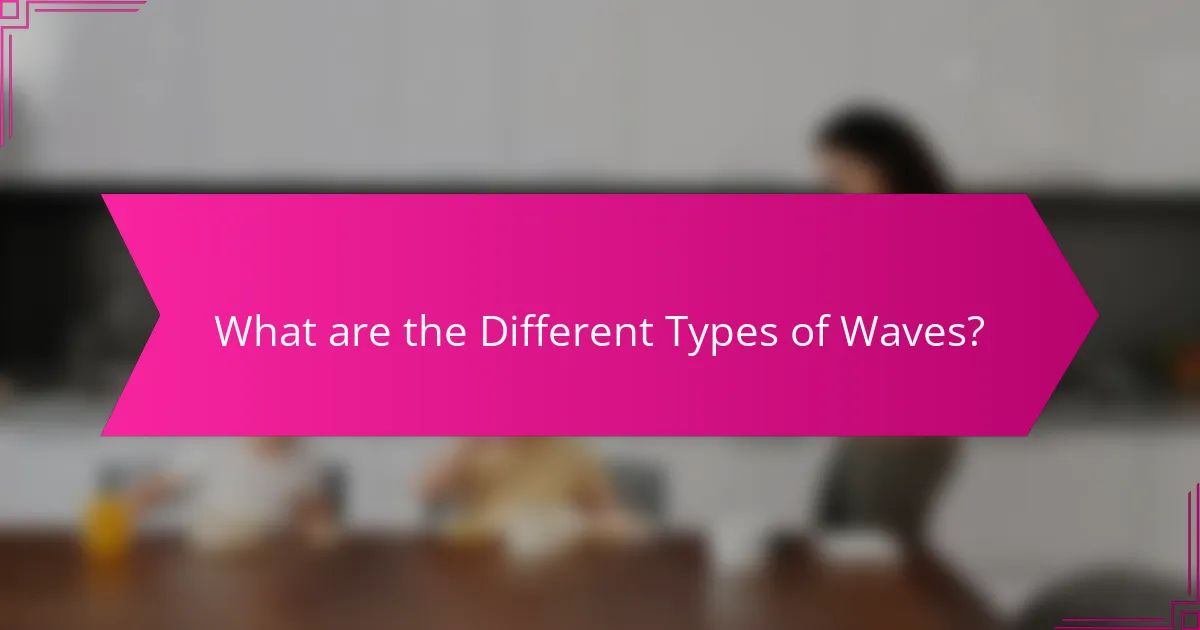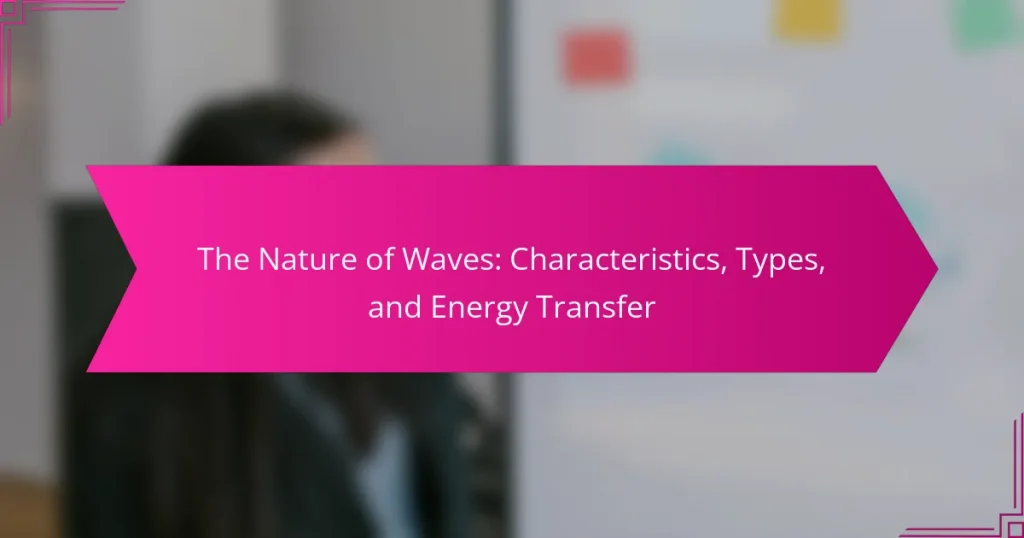Waves are disturbances that transfer energy through space or matter, categorized into two primary types: mechanical waves, which require a medium, and electromagnetic waves, which do not. Mechanical waves can be further divided into transverse and longitudinal waves, while electromagnetic waves encompass a spectrum from radio waves to gamma rays. The article explores the characteristics of waves, their role in energy transfer, and their applications across various fields, including natural processes such as ocean wave erosion, sound communication, and seismic activity. Additionally, it discusses how the energy carried by waves is influenced by amplitude and frequency, highlighting their significance in both ecosystems and human technologies.

What are Waves and Their Importance in Nature?
Waves are disturbances that transfer energy through space or matter. They can be mechanical, such as sound waves, or electromagnetic, like light waves. Waves play a crucial role in various natural processes. For instance, ocean waves shape coastlines through erosion and sediment transport. Sound waves enable communication among animals and humans. Seismic waves provide insights into the Earth’s interior and help predict earthquakes. Additionally, waves in the electromagnetic spectrum are essential for solar energy and photosynthesis in plants. Thus, waves are fundamental to the functioning of ecosystems and human activities.
How do Waves Manifest in Different Mediums?
Waves manifest differently in various mediums based on their physical properties. In solids, waves travel through vibrations of particles closely packed together. For example, sound waves move as longitudinal waves, compressing and expanding the material. In liquids, waves also move through particle interactions, but the particles are less tightly packed than in solids. This allows waves to travel with less speed compared to solids. In gases, waves manifest as sound waves, traveling through the air by compressing and rarefying air molecules. The speed of sound in air is approximately 343 meters per second at room temperature. Each medium’s density and elasticity affect wave speed and behavior. For instance, sound travels faster in water than in air due to water’s higher density.
What are the key characteristics of waves in various mediums?
Waves exhibit distinct characteristics depending on the medium through which they travel. In solids, waves can be longitudinal or transverse. Longitudinal waves compress and expand the medium, while transverse waves move perpendicular to the direction of energy transfer. In liquids, waves are primarily longitudinal, as seen in sound waves. The molecules in liquids can move freely, allowing for efficient energy transfer. In gases, waves also travel as longitudinal waves. Their speed is influenced by temperature and pressure, with sound traveling faster in warmer gases. Each medium affects wave speed, wavelength, and frequency. For example, sound waves travel faster in water than in air due to the denser molecular structure. These variations are essential for understanding wave behavior across different environments.
How do the properties of the medium affect wave behavior?
The properties of the medium significantly influence wave behavior. The medium’s density affects wave speed; denser media generally transmit sound waves faster. For example, sound travels faster in water than in air due to water’s higher density. Elasticity of the medium also plays a crucial role. A more elastic medium allows waves to propagate more efficiently. For instance, seismic waves travel quicker through solid rock compared to softer soil. Additionally, temperature can impact wave behavior. Increased temperature typically decreases density and can alter wave speed. In summary, factors like density, elasticity, and temperature of the medium directly determine how waves propagate and behave.
What are the Fundamental Characteristics of Waves?
Waves are disturbances that transfer energy through a medium or space. They have fundamental characteristics including wavelength, frequency, amplitude, and speed. Wavelength is the distance between successive crests or troughs. Frequency refers to the number of cycles that pass a point per unit time, measured in Hertz. Amplitude indicates the maximum displacement from the rest position. Speed is the rate at which the wave propagates through the medium. These characteristics are essential for understanding wave behavior in various contexts, such as sound, light, and water waves.
What is wavelength and how does it influence wave phenomena?
Wavelength is the distance between consecutive points of a wave that are in phase, such as crest to crest or trough to trough. It is a fundamental characteristic of waves, influencing their behavior and properties. Wavelength determines the frequency of a wave, as they are inversely related; shorter wavelengths correspond to higher frequencies and vice versa. This relationship affects various wave phenomena, including diffraction, interference, and the Doppler effect. For instance, in sound waves, longer wavelengths produce lower pitches, while shorter wavelengths yield higher pitches. In light waves, different wavelengths correspond to different colors in the visible spectrum. Thus, wavelength plays a crucial role in how waves interact with their environment and how they are perceived.
How does frequency relate to wave energy and perception?
Frequency directly influences wave energy and perception. Higher frequency waves carry more energy than lower frequency waves. This is due to the relationship defined by the equation E = hf, where E is energy, h is Planck’s constant, and f is frequency. For example, electromagnetic waves like gamma rays have high frequencies and high energy. In contrast, radio waves have lower frequencies and less energy.
Perception of waves, such as sound or light, is also affected by frequency. In sound, higher frequencies correspond to higher pitches. In light, frequency determines color; higher frequencies appear violet, while lower frequencies appear red. Research shows that humans can perceive sound frequencies from 20 Hz to 20 kHz. This range affects how we interpret sounds in our environment.
Thus, frequency is crucial in determining both the energy of waves and how they are perceived by humans.
What role does amplitude play in wave intensity?
Amplitude directly influences wave intensity. Higher amplitude results in greater intensity. Intensity is proportional to the square of amplitude. For example, doubling the amplitude increases intensity by a factor of four. This relationship applies to various wave types, including sound and light. In sound waves, higher amplitude correlates with louder sounds. In light waves, greater amplitude means brighter light. Thus, amplitude is a key determinant of wave intensity.

What are the Different Types of Waves?
Waves are disturbances that transfer energy through space or matter. There are two primary types of waves: mechanical waves and electromagnetic waves. Mechanical waves require a medium to travel, such as sound waves in air or water waves in the ocean. Electromagnetic waves do not require a medium; they can travel through a vacuum, such as light waves.
Mechanical waves can be further categorized into transverse waves and longitudinal waves. In transverse waves, particles of the medium move perpendicular to the direction of wave propagation, like waves on a string. In longitudinal waves, particles move parallel to the direction of wave propagation, like sound waves.
Electromagnetic waves include a spectrum of waves, ranging from radio waves to gamma rays. Each type of electromagnetic wave has different properties and applications. For example, radio waves are used for communication, while gamma rays are used in medical imaging.
This classification of waves is essential in understanding their behavior and applications across various fields, including physics, engineering, and communication technologies.
What distinguishes Mechanical Waves from Electromagnetic Waves?
Mechanical waves require a medium for propagation, while electromagnetic waves do not. Mechanical waves travel through solids, liquids, or gases, such as sound waves in air. Electromagnetic waves, like light, can move through a vacuum. Mechanical waves are characterized by particle displacement in the medium. In contrast, electromagnetic waves consist of oscillating electric and magnetic fields. The speed of mechanical waves depends on the medium, whereas electromagnetic waves travel at the speed of light in a vacuum. This fundamental difference highlights how each wave type interacts with its environment.
How do transverse and longitudinal waves differ in structure?
Transverse and longitudinal waves differ fundamentally in their particle movement relative to wave propagation. In transverse waves, particles oscillate perpendicular to the direction of wave travel. This creates crests and troughs in the wave structure. Examples include light waves and waves on a string. In contrast, longitudinal waves have particles that move parallel to the direction of wave travel. This results in compressions and rarefactions along the wave. Sound waves in air are a primary example of longitudinal waves. The structural differences between these wave types affect their propagation and energy transfer characteristics.
What are examples of mechanical waves in everyday life?
Examples of mechanical waves in everyday life include sound waves, water waves, and seismic waves. Sound waves travel through air when we speak or play music. Water waves occur when we throw a stone into a pond, creating ripples. Seismic waves are generated during earthquakes, traveling through the Earth. These waves require a medium to propagate, unlike electromagnetic waves. Sound waves can be measured in decibels, while water waves can be observed by their amplitude and frequency. Seismic waves are detected using specialized instruments called seismographs.
What are the applications of Electromagnetic Waves?
Electromagnetic waves have various applications across multiple fields. They are utilized in communication technologies, such as radio and television broadcasting. Electromagnetic waves enable wireless internet connections through microwaves. They are essential in medical imaging, specifically in MRI and X-ray technologies. Additionally, they are employed in radar systems for navigation and weather monitoring. Electromagnetic waves are also used in industrial heating processes, such as microwave ovens. Furthermore, they play a crucial role in remote sensing and satellite communications. Their diverse applications highlight their significance in modern technology and science.
How do radio waves facilitate communication technologies?
Radio waves facilitate communication technologies by transmitting information over long distances without physical connections. They are a type of electromagnetic radiation with wavelengths ranging from one millimeter to 100 kilometers. Communication devices, such as radios and cell phones, use radio waves to send and receive signals. These signals carry audio, video, and data. Modulation techniques alter the radio wave properties to encode information. For example, amplitude modulation (AM) changes the wave’s amplitude, while frequency modulation (FM) alters its frequency. The transmission and reception of radio waves occur through antennas, which convert electrical signals into radio waves and vice versa. The widespread use of radio waves enables wireless communication, including broadcasting, mobile networks, and satellite communications. This technology supports billions of users globally, demonstrating its critical role in modern communication systems.
What is the significance of visible light in our daily experiences?
Visible light is significant in our daily experiences as it enables vision and influences various biological processes. Humans perceive visible light through photoreceptors in the eyes. This perception allows us to navigate our environment and recognize objects. Additionally, visible light plays a crucial role in photosynthesis, enabling plants to produce oxygen and food. This process supports life on Earth, contributing to the food chain. Furthermore, visible light affects circadian rhythms, regulating sleep and wakefulness. Studies show that exposure to natural light improves mood and productivity. The presence of visible light is essential for both physical and mental well-being.

How do Waves Transfer Energy?
Waves transfer energy through the movement of particles in a medium. In mechanical waves, such as sound or water waves, energy is conveyed by the oscillation of particles. These particles move in a specific pattern, creating areas of compression and rarefaction or crests and troughs.
In electromagnetic waves, energy is transferred through oscillating electric and magnetic fields. This transfer occurs without the need for a medium, allowing these waves to travel through a vacuum.
The energy carried by waves is proportional to their amplitude and frequency. Higher amplitude waves carry more energy, while higher frequency waves also convey greater energy.
For example, ocean waves can transfer significant energy to objects, such as boats, through their height and speed. This phenomenon is observable during storms when wave energy can cause erosion along coastlines.
Overall, waves effectively transfer energy by causing particles to vibrate or by creating oscillating fields, depending on their type.
What mechanisms are involved in wave energy transfer?
Wave energy transfer occurs through mechanisms such as particle motion, wave propagation, and energy conversion. Particle motion involves the oscillation of water molecules in circular or elliptical paths. This motion transfers energy from one particle to another, facilitating wave movement. Wave propagation refers to the movement of energy through the medium, which is primarily water in ocean waves. Energy conversion occurs when wave energy is transformed into other forms, such as kinetic energy in turbines. These mechanisms work together to transfer energy across distances, impacting coastal and marine environments.
How does energy transfer occur in ocean waves?
Energy transfer in ocean waves occurs through the movement of water particles in a circular motion. As waves travel across the surface, they carry energy from one location to another. This movement is primarily caused by wind blowing over the water’s surface. The energy from the wind is transferred to the water, creating waves.
In deep water, particles move in circular orbits, with energy traveling forward while water itself moves in a nearly vertical motion. As waves approach the shore, the water becomes shallower, causing the wave to slow down and increase in height. This process is known as wave shoaling.
When waves break, they release their energy, resulting in surf and turbulence. This energy transfer is crucial for coastal erosion and sediment transport. Studies have shown that wave energy can also be harnessed for renewable energy sources, demonstrating the practical implications of this energy transfer.
What is the role of wave interference in energy distribution?
Wave interference plays a crucial role in energy distribution by affecting how energy is transferred through waves. When two or more waves overlap, they can interfere constructively or destructively. Constructive interference occurs when waves align, amplifying the energy in that region. Destructive interference happens when waves cancel each other out, reducing energy in that area.
This phenomenon is essential in various contexts, such as sound, light, and water waves. For example, in acoustics, constructive interference can enhance sound quality, while destructive interference can create dead spots. In optics, interference patterns are used in technologies like holography and interferometry.
Research shows that wave interference significantly influences energy distribution in systems, leading to varied applications in engineering and physics. Understanding this concept helps in optimizing energy transfer in different mediums.
How do Waves Impact the Environment?
Waves impact the environment by influencing coastal erosion, sediment transport, and marine ecosystems. Coastal waves erode shorelines, reshaping landforms over time. This erosion can lead to habitat loss for coastal flora and fauna. Waves also transport sediments, redistributing materials along coastlines. This process creates and maintains beaches and estuaries. Furthermore, waves affect water mixing in oceans, promoting nutrient distribution. This mixing supports marine life and influences food chains. Studies show that wave energy can significantly alter coastal landscapes and ecosystems. For instance, research indicates that wave action is a primary driver of sediment dynamics in coastal environments.
What effects do sound waves have on marine life?
Sound waves significantly affect marine life in various ways. Marine organisms rely on sound for communication, navigation, and foraging. High-intensity sound waves can disrupt these vital behaviors. For example, loud noises from ships and industrial activities can lead to disorientation in whales and dolphins. Research indicates that exposure to such sounds can cause stress and even strandings in these species. Additionally, sound pollution can interfere with the mating calls of fish, affecting reproduction. Studies have shown that prolonged exposure to noise can lead to changes in behavior and habitat use among marine animals. Overall, sound waves play a crucial role in the health and survival of marine ecosystems.
How do seismic waves inform us about geological events?
Seismic waves inform us about geological events by providing data on the Earth’s internal structure and movement. These waves are generated by events such as earthquakes and volcanic eruptions. They travel through the Earth and are detected by seismographs. Analysis of seismic wave patterns reveals information about the location and depth of these events. Different types of seismic waves, including P-waves and S-waves, behave differently as they pass through various materials. For instance, P-waves travel faster through solid and liquid, while S-waves only move through solids. This behavior helps scientists determine the composition of the Earth’s layers. Historical data from seismic waves has been crucial in understanding tectonic plate movements. For example, the 1906 San Francisco earthquake provided insights into fault lines and seismic risk.
What are Practical Applications of Understanding Waves?
Understanding waves has several practical applications across various fields. In telecommunications, waves are essential for transmitting signals over long distances. Radio waves enable wireless communication, allowing devices to connect without physical cables. In medicine, ultrasound waves are used for imaging and therapeutic purposes. This technology helps in diagnosing conditions and guiding surgical procedures.
In engineering, waves play a crucial role in structural analysis. Understanding wave behavior helps in designing buildings and bridges to withstand seismic activity. In environmental science, waves are studied to understand ocean currents and their impact on climate. This knowledge aids in predicting weather patterns and managing natural resources. Lastly, in acoustics, understanding sound waves improves audio technology, enhancing experiences in music and entertainment.
How can knowledge of waves improve technology and innovation?
Knowledge of waves can significantly enhance technology and innovation. Understanding wave properties leads to advancements in communication systems. For example, radio waves enable wireless communication, impacting mobile networks and broadcasting. Knowledge of sound waves has improved audio technology, enhancing sound quality in devices. Light waves are fundamental in optics, leading to innovations in lasers and imaging technologies. Research in wave behavior has also contributed to medical technologies, such as ultrasound imaging. These applications illustrate how wave knowledge drives technological progress across various fields.
What best practices can be adopted for harnessing wave energy?
Best practices for harnessing wave energy include selecting optimal locations for wave energy converters. Coastal areas with consistent wave patterns are ideal. Implementing advanced technology enhances energy capture efficiency. Regular maintenance of equipment ensures longevity and reliability. Environmental assessments are crucial to minimize ecological impact. Collaborating with local communities fosters support and sustainable practices. Utilizing hybrid systems can integrate wave energy with other renewable sources, maximizing output. Monitoring systems should be in place to track performance and adapt strategies as needed.
The main entity of the article is ‘waves’, which are disturbances that transfer energy through various mediums. The article provides an in-depth exploration of the characteristics, types, and energy transfer mechanisms of waves, including mechanical and electromagnetic waves. Key topics include how waves manifest in different mediums, their fundamental characteristics such as wavelength, frequency, and amplitude, and the impact of wave behavior on the environment. Additionally, the article discusses practical applications of wave knowledge in fields like telecommunications, medicine, and renewable energy, highlighting the significance of understanding waves for technological advancement and innovation.


